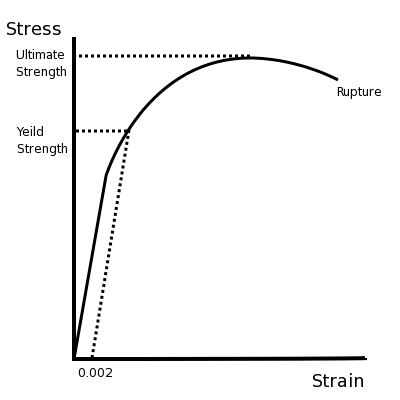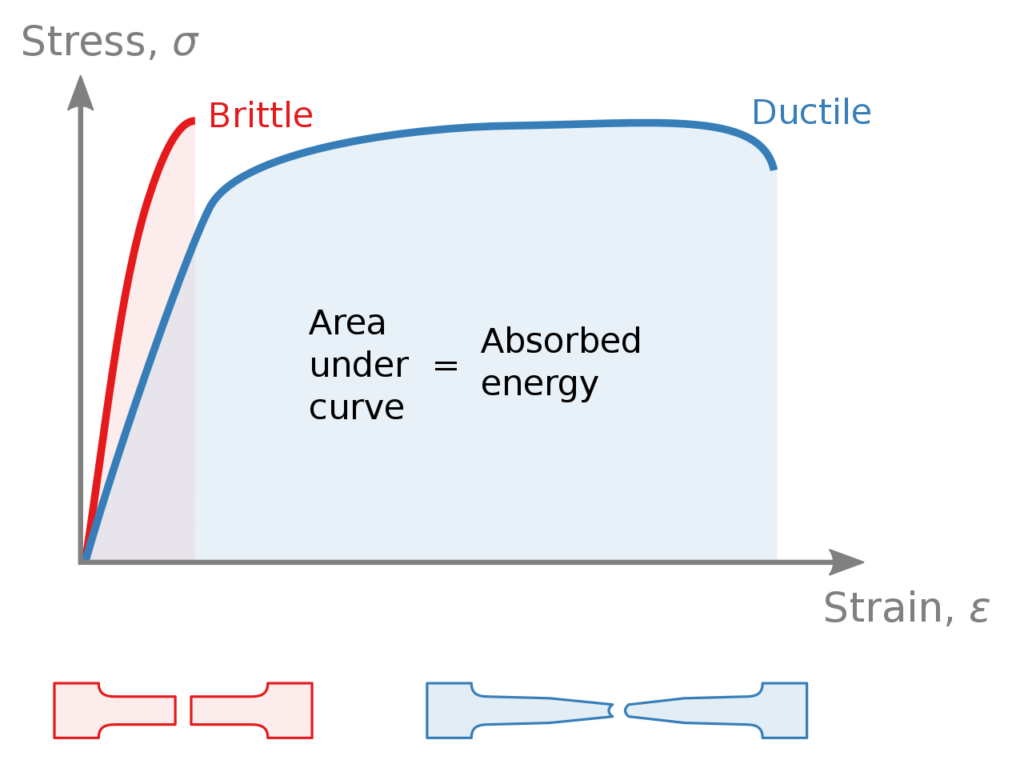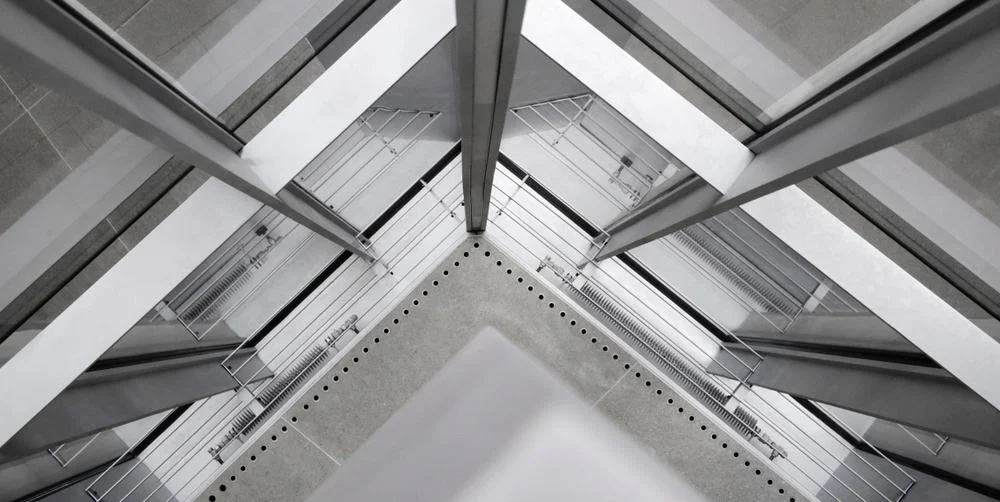The ductility of a material refers to its ability to undergo a large amount of inelastic deformation until it breaks. It is usually considered a soft property of any material. However, in reality, ductile materials such as aluminum have an essential advantage in every structural application due to their good ductility.
Aluminum, which is one of the most commonly used metals in high-rise structures and skyscrapers, has high ductility. However, its ductility does vary depending on the heat treatment it received and the alloying elements added to it, resulting in different types of aluminum alloys.
Below, we first detail the importance of ductility in structural applications and then explore the advantages and disadvantages of aluminum ductility.
The Importance of Ductility in Structural Applications
Deformability and ductility are two major properties of a material that define its lateral strength. A material with good ductility can undergo a large elongation before it collapses, making it one of the best materials for ensuring the durability and safety of structures.
To better understand ductility, let’s look at a stress-strain graph of material, shown below:

Here, the yield strength represents the point up to which the material can bear a certain load before it starts to deform. Up to this point, the material can reverse back to its original shape once the load is removed, just like rubber.
If we increase the load beyond the yield point, the material will show plastic deformation. That means the material will have permanent deformity, but it will not break until the load reaches the ultimate strength point in the curve. Beyond that point, the material will rupture before breaking down completely.
The phase between the yield strength and the ultimate strength represents the ductility of the material. The ductility of a material is measured in terms of ductility ratio or ductility factor, as shown below.

Ideally, the value should be between four to five.
In the case of a highly ductile material, these two points are very far from each other, and thus, the material can undergo large plastic deformation before collapse. However, in the case of a brittle material, it is the opposite.
 Different metals have different ductility. Materials like gold and silver can be drawn into thin wires, as they are highly ductile. On the other hand, tungsten carbide and cast iron are highly brittle. Now, let’s discuss aluminum ductility.
Different metals have different ductility. Materials like gold and silver can be drawn into thin wires, as they are highly ductile. On the other hand, tungsten carbide and cast iron are highly brittle. Now, let’s discuss aluminum ductility.
|
Top-Grade Aluminum for Every Purpose and Industry |
||
|
New Aluminum Plate 6061 |
New Aluminum Rectangular Bar |
All Aluminum Shapes |

|

|

|
|
Customizable thickness: Measure in inches. You can get various options for all industry applications.
Can be cut to specific shapes and sizes: Excellent weldability to cater to unique project needs. Corrosion resistance: Grades like 6061-T651 are perfect for marine hardware applications that require superior rust resistance. |
Environmental resilience: Due to its heat treatable nature, 6061 aluminum does well in extreme conditions.
Wide selection of sizes and dimensions: Choose your sizes based on tensile strength, width, and weight. Good machinability: It’s lightweight and high strength makes it flexible for a number of applications. |
Reliable supply: Consistent, certified aluminum stock you can trust.
High-quality material: Superior-grade aluminum for precision needs. Custom cuts: Accurate cuts down to thousandths of an inch. |
Advantages of Aluminum Ductility
Pure aluminum is ductile in nature. However, aluminum comes in different grades. The addition of extra elements and the type of heat treatment affect its ductility, creating various aluminum alloys.
The following table lists the ductility of some commonly used aluminum alloys compared to some commonly used steel alloys:
| Alloy | Heat Treatment | Elongation at Break (at 77°F) |
| Aluminum 3003 | O (Annealed) | 40% |
| H14 (Strain Hardened) | 16% | |
| Aluminum 5052 | O | 30% |
| H32 | 18% | |
| Aluminum 6061 | O | 30% |
| T6 | 17% | |
| AISI 4140 Steel | Oil Quenched | 15% |
| AISI 4340 Steel | Normalized | 12% |
| AISI 6150 Steel | Oil Quenched | 14% |
Clearly, all forms of aluminum have better ductility than steel. With subsequent heat treatments, aluminum achieves higher strength but at the cost of ductility. Nevertheless, aluminum ductility offers an essential advantage in structural applications.
In the event of any unexpected overload, a brittle structure (made up of only steel) will suddenly collapse, whereas a ductile structure (steel + aluminum) undergoes a controlled collapse. The addition of ductility to the iron structure through beams or suspension cables increases its maximum potential as a whole; thus, at the time of an earthquake, it doesn’t collapse suddenly but yields in a controlled manner. This can be life-saving, as it gives people in life-threatening situations sufficient time to escape. This is the reason ductile materials like aluminum are used as the major structural element in earthquake-prone areas.
| Science Fact: Aluminum’s ductility is so remarkable that it can be stretched into thin wires or beaten into thin sheets, a property that makes it ideal for manufacturing products like aluminum foil. |
Disadvantages of Aluminum Ductility
As aluminum is a relatively soft material with a low melting point, it can be somewhat challenging to machine. Depending on its alloying elements, aluminum can melt due to heat produced by the friction between the tool and the workpiece. As a result, gummy chips can begin to build up around the blade and offer resistance to the tool with each pass. When enough materials build up, the blade can grab onto the aluminum, potentially causing injuries to the machinist. Cutting blades can also quickly wear out due to the soft yet abrasive nature of aluminum, and the costs associated with having to purchase new tools can be significant.
It’s important to select the right cutting tool for the job and follow best practices to produce faster cuts with minimum material losses. Without industrial-grade sawing equipment and the right blades (non-ferrous/carbide-tipped wood), it is impossible to achieve a clean cut with ductile materials like aluminum.
Partnering with an experienced metal supplier will help you get your desired aluminum cut-to-precision without having to spend money on new tools or struggle with new techniques.
Impact of Alloying and Heat Treatment on Aluminum’s Ductility
Starting with pure aluminum, known for its high ductility, the addition of other metals to create an aluminum alloy can dramatically change its properties. While pure aluminum is soft and highly ductile, the introduction of elements like copper, magnesium, or zinc transforms it into a much stronger material. This is particularly important when considering the tensile strength and thermal conductivity of aluminum products. The balance between strength and ductility is crucial for applications where flexibility and durability are essential.
Heat treatment plays a pivotal role in this transformation. It alters the mechanical properties of the aluminum alloy, impacting not only its strength but also its ductility. The process involves heating the alloy to a specific temperature and then cooling it at a controlled rate. This treatment can significantly improve the thermal conductivity of the alloy, making it more suitable for applications where heat dissipation is crucial.
Moreover, certain aluminum alloys are designed with corrosion resistance, an essential attribute for products exposed to harsh environments. The corrosion-resistant nature of these alloys extends the life and maintains the integrity of aluminum products in various applications.
The crafting of aluminum alloys and the application of heat treatment are key to optimizing the mechanical properties of aluminum. This manipulation enhances the material’s utility, expanding its applications across different industries. The balance between maintaining the innate ductility of pure aluminum while enhancing other properties like tensile strength, thermal conductivity, and corrosion resistance is a testament to the versatility and adaptability of aluminum as a material.
Purchase High-Quality Aluminum From an Experienced Supplier
For more than two decades, Industrial Metal Service has been supplying new and recycled aluminum and aluminum alloys to the San Francisco Bay Area and beyond. Our wide inventory includes 6061 aluminum plate stock, bar stock, and round stock, as well as 5080 aluminum tooling plate and MIC-6 aluminum plate. We also supply other metals such as copper, titanium, and specialty metals such as Hastelloy and Invar 36.
Take advantage of our state-of-the-art metal sawing services for precision-cut aluminum, each and every time. With a surface finish as low as 12 microinches, our MetlSaw NF12-T12 can handle up to 12-inch thick aluminum plates and can cut them up to 12 feet long.
 Angle
Angle Cast Plate
Cast Plate Diamond Plate
Diamond Plate Flat Bar
Flat Bar Plate
Plate Round Bar
Round Bar Square Bar
Square Bar Square Tubing
Square Tubing Round Tubing
Round Tubing Angle
Angle Channel
Channel Diamond Plate
Diamond Plate I Beam
I Beam Round Bar
Round Bar Sheet
Sheet Square tubing
Square tubing Round Tubing
Round Tubing Rectangular Tubing
Rectangular Tubing Plate
Plate Rectangular Bar
Rectangular Bar Rectangular Tubing
Rectangular Tubing Round Bar
Round Bar Sheet
Sheet Square Bar
Square Bar Square Tubing
Square Tubing
